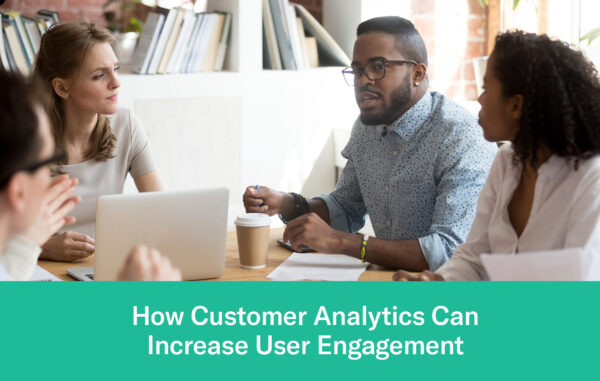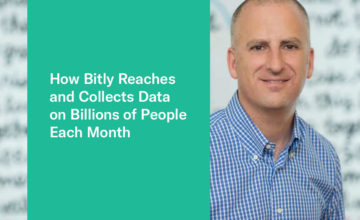In many ways, increasing user engagement is the hallmark of a successful company. According to a Gallup poll, fully engaged customers represent a 23% premium over an average customer when it comes to share of wallet, profitability, revenue, and relationship growth. In some industries, it’s even greater. For example, Gallup found that companies that successfully engage their B2B customers realize 63% lower customer attrition and a 55% higher share of wallet. Even in the world of leisure and hospitality, fully engaged hotel guests spent 46% more per year than disengaged guests. That’s a huge difference!
In short: increasing user engagement is important, but it’s hard to get users to engage without understanding how and why they’re engaging in the first place. Enter: customer analytics.
The type of data analysis that typically helps drive user engagement requires interpreting a number of different metrics, but largely, the focus is on behavioral data. At what point are leads and new users entering your sales funnel and what point are they dropping off? What is the LTV of your average customer? Who are your customers, how do they live, and what do they love?
Analyzing user data can give you insights that help solicit enthusiastic user engagement and onboarding — the kind that gets your company paid. These tips will help you use data to change the way you interact with customers and drive conversions and engagement across all platforms.
Data Analysis Makes Personalization Possible — And It Works!
You can’t give consumers the content they want to interact with if you don’t know what kind of content that is — and the truth is that most businesses don’t know how to do personalization right.
According to an IBM report, 90% of companies consider personalization an important part of their business strategies, but just 39% of consumers claim they’ve received relevant brand communications. A customer isn’t going to interact with company messaging they don’t need or want.
This is where great data comes in.
Data analysis on consumer behaviors can help you understand what type of messaging works for which type of customers, and then you can target specific segments from there. For example, this can be used in an email campaign where Indicative collects people’s insights (i.e. data on core consumer behaviors) and helps you create highly personalized market segments. In other words, you’ll learn what customers want, so you can send them the type of message they’re looking for — and the effectiveness in this strategy has been proven over and over again.
According to research, email segmentation and individualized email campaign messaging is the most effective type of personalization, and personalized emails have six times higher traction rates than those that don’t.
Eliminate The Bumps In Your Sales Funnel With Data Analysis
Data analysis regarding consumer behavior and user experience goes a lot deeper than simply demographics. You can actually use insights to help you determine points of friction within your sales funnel. For example, if a high number of users are abandoning their cart at the payment stage of mobile checkout, it may be a signal that mobile checkout takes too long because users aren’t bothered to find their credit card. In this case, a solution might be having your UX team add a PayPal checkout option.
Similarly, you may find out that a wealth of users are dropping off after visiting your site from Instagram. This could be a signal to implement more specific linking by connecting your product catalog to your business profile. Whatever the reason, services like Indicative can help you uncover which touchpoints in your sales funnel are key to customer acquisition and which ones are stopping them by analyzing multipath customers journeys.
A/B Testing Tells You What You’re Doing Wrong (and Right!)
One of the key features of data analysis using Customer Analytics is that you can use it on marketing campaigns you’re already running to increase engagement (and thus, your ROI), to collect information for future campaigns and to brainstorm new features.
The latter can be done through A/B testing, which is hard-wired to maximize the number of people who view your marketing messages. Here, you’ll test anything from subject lines and message content to format, call-to-action buttons, and landing pages to see which solicits the best response from users.
After a few A/B tests, your company should be able to determine trends and nail down what works and what doesn’t. Services like Indicative can help in the process.
Behavior-Triggered Actions
A/B testing is useful, but it also isn’t the end all be all of data analysis. Data analysis — especially when used in conjunction with automation — can help you solicit user engagement by triggering certain actions based on user behavior (think: personalized emails or dynamic social ads).
For example, this is commonly seen in cart abandonment campaigns. If a user leaves an item in their shopping cart before bouncing from a page, it may trigger additional messaging — like an email or app notification — that reminds the user they were interested in that item.
Conclusion
Data analysis is only as good as the data you collect, which is why it’s important to use a real-time analytics product like Indicative that understands how to collect and interpret data with engagement and conversions in mind. Luckily, in a world that’s increasingly digital, there’s a wealth of data to go around.
If this sounds like something you’re interested in, get in contact with an Indicative product specialist to learn more.
Contributor’s Statement

Ryan Gould, Vice President of Strategy and Marketing Services at ElevationB2B
From legacy Fortune 100 institutions to inventive start-ups, Ryan brings extensive experience with a wide range of B2B clients. He skillfully architects and manages the delivery of integrated marketing programs, and believes strongly in strategy, not just tactics, that effectively aligns sales and marketing teams within organizations.
——
If you’re interested in sharing your industry knowledge as a contributor among our blog, be sure to reach out to tara.mcquaide@indicative.com, today.



